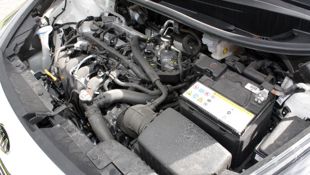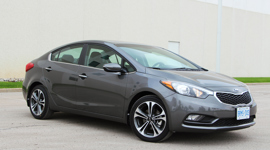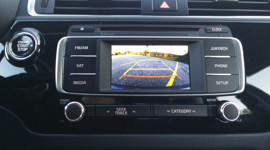Vehicle Type
Owner-stated complaints about this generation Kia Rio are minor and not worrisome in nature.
Compact sedan or hatchback
History/Description
Kia’s latest-generation Rio hit the road in 2011 as a 2012 model, priced and equipped to give competitors from around the globe a run for their money. Today, compact cars like this one occupy the largest and most competitive vehicle segment in Canada – and automakers like Kia are making the best small cars the market has ever seen. This generation of Kia Rio, which remains on sale as of writing, is an example of the trend. The new generation is set to hit dealerships in 2017 as model year 2018.
Rio is available in both sedan and five-door hatchback configurations to meet the needs of a wide range of shoppers. Both models boast class-leading cargo capacity and folding rear seats for maximum flexibility.
Note that thanks to Kia’s so-called 5-5-5 warranty, Rio is backed by 5 years or 100,000 kilometres of comprehensive warranty coverage, powertrain protection and roadside assistance anywhere in North America. Finding a unit with factory warranty remaining should be no issue, given the age of the current generation.
Depending on the model selected, feature content may include heated leather, a heated steering wheel, navigation, push-button start, cabin air ionizer, automatic climate control, Bluetooth media streaming, sunroof, and plenty more. Also available is the Microsoft UVO system, which allows drivers to manipulate a variety of functions at a simple button press and spoken command.
Engines / Trim
All units are powered by a 1.6L four-cylinder with direct injection, continuously variable valve timing, and 138 horsepower. A six-speed transmission in the driver’s choice of automatic or manual drives the front wheels on all models. Rio 5 or Rio 5-door is the designation for the hatchback model; and trim grade nomenclature sees EX and SX models take mid-range and top-line spaces in the product lineup respectively.
What Owners Like
Interior and exterior styling, fuel efficiency, feature content for the money, and an upscale cabin design are all highly rated by owners of this generation of Kia Rio. A multitude of charge ports and a deep, large trunk are also noted. Headroom, even for taller drivers, is said to be generous.
What Owners Dislike
Some owners wish for roomier rear seats, and a more comfortable ride on rougher roads, especially on models with larger wheels. Though the engine performs well, some owners wish it operated more quietly, and/or with a more pleasing sound. Interestingly, numerous owners say it’s difficult to mount anything to the windshield, on account of its steep angle. Further, numerous owners agree that the Rio’s air conditioner isn’t quite powerful enough on very hot days.
here's a look at some Kia Rio owner reviews
The Test Drive
Many owner-stated complaints about this generation Kia Rio are minor and not worrisome in nature – with the most common actually being rattles that originate from the dashboard or steering column.
Complaints of niggling rattles are followed closely by numerous complaints about the available UVO touchscreen/voice-activated central command interface for media and communications. Sporadic operation, crashing, lagging, failure to power up, and failure to respond have all been reported within the owner community. Ditto complete failure of any audio playback to make its way to the speakers.
In some cases, a hard reset of the UVO system fixes the issue, though this is usually temporary – and many owners have reported having to replace the entire head unit, sometimes at a high price, out of warranty. Here’s some more reading. And a little more. Best defense if you’re set on a used Rio with UVO? Run the unit through its paces, exploring all functions several times over the course of your test drive. Also ask the seller if the unit has ever been replaced. As problems with this system are sporadic in nature and typically come with minimal, if any, warning, it’s difficult to tell on a test drive if any problems can be expected. Avoid this system for maximum peace of mind.
Rio runs a direct-injected engine, and like many direct-injected engines, owners have reported issues around valve gunk and oil consumption. Here’s some more reading, and a look at one modification some owners make to help fend off valve gunk accumulation.
Valve gunk is a characteristic of most direct injection engines, and can’t be remedied or cleaned via pour-in-tank valve cleaning products. Signs of excessive valve gunk may include a “check engine” light and misfire code, poor performance, or a rough idle. Using a top-grade fuel at all times, changing oil on time, and keeping on top of spark plug maintenance intervals can all indirectly help combat excessive valve gunk buildup.
While driving, turn off the radio and climate control fan, and at low revs, press the throttle, and listen for a chirping, squealing or cricket-like noise from under the hood. The likely culprit is a rubber belt used to drive the alternator and other components, which may have become worn or stretched. The annoying sound effects are the worst part of this problem, since replacing a stretched or worn accessory belt is relatively easy and inexpensive.
Check the air conditioning system as well. Confirm that it pipes cool air into the cabin in quick order once activated, noting that numerous owners say the Rio’s A/C system isn’t particularly powerful, though it should prove adequate in most climates. Any unwelcome noises, lugging of the engine, or poor A/C performance should be investigated. Further, though largely inconclusive, some owners have reported A/C system performance issues that were actually caused by an overdue cabin air filter change, which is part of regular maintenance. Ask the seller if they know when the cabin air filter was last changed. If they don’t know what a cabin air filter is, the car will need one.
The Verdict
Most of Rio’s common problems are fairly minor in nature, with few if any appearing systematic or rampant. By and large, the owner’s community has enjoyed reliable and worry-free motoring thus far. The fact that no recalls are listed for this model is also reassuring. As such, finding a top-notch unit should be a function of seeking a thumbs-up from a mechanic after a simple pre-purchase test of the entire vehicle, including an A/C system check and a scan of the ECU for stored trouble codes. Buy confidently if the unit checks out.
Crash Test Ratings
NHTSA: 4/5 stars (2016)
IIHS: Test results here
































